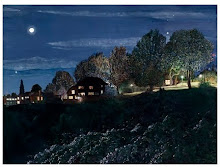It's another beautiful day at the Viewpoint. The water has stripes--well, bands--of different shades of blue. I'm not clear on why that happens, but I've seen it many times before. Does it have to do with variations in the degree of windiness in different areas, I wonder, which would cause different wave patterns, which would then reflect the sky in different ways?
At the head of the trail there's a floppy plant. That's not the official name of the plant--just the category I put it in. When I say "floppy plant," I mean any of that multitude of plants that have a few big floppy leaves rather than a network of lots of little leaves. I imagine there's some official designation for plants of this kind. I'll touch on that subject another day. Today I want to go over the classification of clouds, since there are so many of them to be seen from the Viewpoint.
Cirroculmulus, cirrus (floccus), cirrus (uncinus), cirrus (fibratus), cirrus (spissatus), cirrostratus (fibratus), cirrostratus (nebulosus), altocumulus (perlucidus), altocumulus (translucidus), altocumulus (floccus), altocumulus (castellanus), altocumulus (lenticularis), altostratus (translucidus), nimbostratus, stratus (nebulosus), stratocumulus (stratiformis), cumulus (humilis and mediocris), cumulus (congestus), cumulonimbus (calvus), cirrostratus, cirronimbus (cappilatus), cumulonimbus, cumulonimbus (mammatus) are all terms used in the classification of clouds. The painter John Constable would have loved the Viewpoint for its great variety of clouds.
From the Viewpoint one sees many of the Cascade Mountains--the range to the east of Seattle. From the highest point in the cemetery across the street, one can also see the Olympics--the mountain range to the west of Seattle, out on the Olympic Peninsula. Another day I'll write more about the mountains.
Tuesday, October 6, 2009
Subscribe to:
Post Comments (Atom)

No comments:
Post a Comment